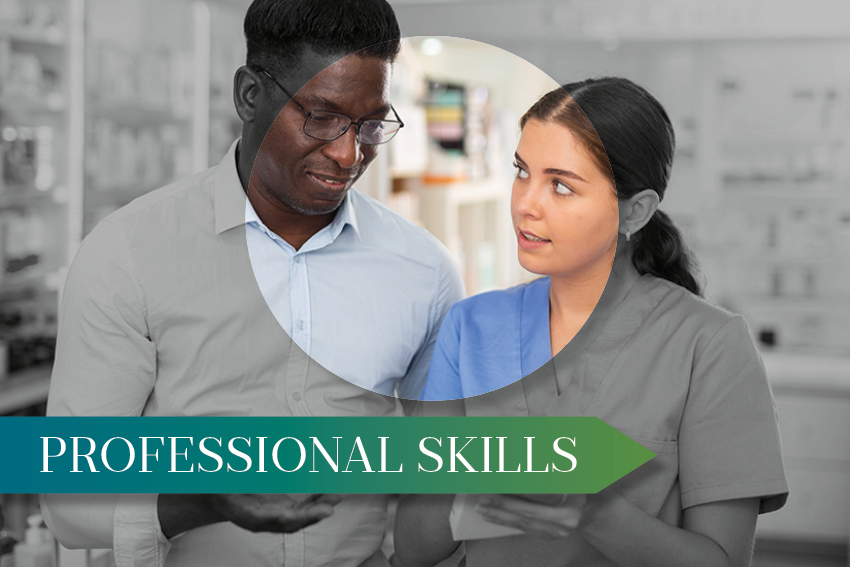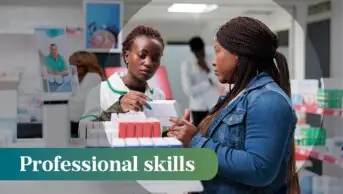
Shutterstock.com
After reading this article, you should be able to:
- Define the term ‘microaggressions’ and list the different types;
- Respond respectfully if you offend someone or make a mistake through a microaggression;
- Use inclusive language to effectively communicate with patients from diverse communities.
Health inequality exists across dimensions and characteristics, such as personal characteristics; ‘protected characteristics’ defined in the Equality Act 2010; lifestyle factors; social networks; and living and working conditions. Ethnicity can affect a person’s experiences of discrimination, exclusion and health inequality[1,2]. Discrimination is not always overt and can be unintentional. Microaggressions are subtle manifestations of bias that can be as harmful as more overt, obvious forms of discrimination. As the regulator for pharmacy, the General Pharmaceutical Council expects pharmacy professionals to be fair and inclusive in their interactions with the public, patients, healthcare professionals, service providers and colleagues[3]. This requires the use of inclusive and bias-free language that does not reinforce stereotypes, stigmatise, exclude or discriminate against certain groups of people, or cause discomfort or offence.
This article explores language that improves rapport and builds relationships with people from under-represented communities, such as those with protected characteristics or from vulnerable communities (e.g. people with mental health conditions). It explains what microaggressions are, how to avoid them, and how to make amends if you make a mistake. Terminology is introduced to support the development of inclusive pharmacy practice that reduces prejudice, discrimination and health inequalities.
Defining microaggressions
Microaggressions are everyday verbal, non-verbal and environmental slights, snubs or insults, which communicate hostile, derogatory or negative messages towards people because of their race, ethnicity, socio-economic background, gender, physical or learning disability, learning difference or belonging to the Lesbian Gay Bisexual Transgender Queer and Intersex (LGBTQI+) community[4]. Microaggressions can be unintentional (based on inherited or acquired beliefs we are unaware of, known as unconscious bias) or intentional (based on conscious bias)[5]. Microaggressions can imply the person is a lesser human being or that they do not belong with the majority group, or they can be threatening and intimidating. This can lead to relegating the person to inferior status and treatment in all aspects of life, including healthcare and employment.
Examples of microaggressions
Microaggressions can take many forms. Some examples include:
- Making assumptions about the behaviour, attitudes, values or beliefs of people from a certain culture (stereotyping) — for example, assuming that all people from an Asian or South Asian background must be good at maths, or that people of the Jewish faith only eat a Kosher diet;
- Making comments on a person’s appearance based on stereotypes — for example, about their hair type, clothes or skin colour;
- Making assumptions about a person’s needs, concerns, ideas and expectations;
- Repeatedly pronouncing a person’s name incorrectly;
- Questioning a person’s nationality, ethnicity or where they are from because it does not match an expectation, which can lead to that person feeling they do not belong, even if they were born or have lived in the UK for some time;
- Using metaphors that can be insulting to people belonging to certain cultures or communities.
Describing people
When we do not know a person very well or do not know their name, we may find other ways to describe them. This must be done in a respectful way that minimises the risk of offending the person and contributes to an inclusive and positive working environment[6].
For example, look at the people in the image below (see Figure). What is unique about one or more of the people featured?

Shutterstock.com
Here are some possible answers:
- One person is not wearing glasses;
- One person is carrying a bag;
- One person is smiling;
- One person has a drinking cup;
- One person seems to be a woman (but we cannot assume their gender identity);
- One person is not wearing a jacket.
There are respectful ways to describe people without referring to personal characteristics (such as ethnic group, skin colour, gender identity) that are less likely to offend and that facilitate a culture of inclusivity and belonging.
Race-related microaggressions
In Box 1, Beryl Navti, clinical lead pharmacist for Child and Adolescent Mental Health Services at Goodmayes Hospital in London, describes her surprise about how a conference delegate treated her because of her race.
Box 1: Microaggressions example — race
Audio: Where are you really from?
Race-related microaggressions are widespread and common. Repeatedly pronouncing someone’s name incorrectly is one example of a race-related microaggression. It demonstrates that someone is not prepared to invest the necessary time to learn how to pronounce it properly. Read more about name pronunciation in a previous article on cultural competence.
Microaggressions in mental health and neurodivergence
People with mental health conditions, such as anxiety disorders and depression, or people with neurodivergence, such as autism, often face stigma about their condition[7,8]. Some people may have misconceptions about what certain diagnoses mean. They may use language that is dismissive, offensive or hurtful, or which trivialises a person’s needs or state of health. These insults, whether intentional or unintentional, can lead to people with mental health conditions or neurodivergence to experience feelings of low self-worth or loss of identity, and result in reluctance to access healthcare services, leading to health inequalities. Pharmacy professionals are often the first port of call for people seeking health advice; therefore, their role in creating an inclusive healthcare environment should not be understated.
In Box 2, Gem Cooke, who lives with an anxiety disorder, describes her experiences of interacting with her local community pharmacy.
Box 2: Microaggression example — mental health
Table 1 lists examples of commonly used language that should be avoided and suggests alternative language that demonstrates dignity and respect for people with a mental health condition or neurodivergence.
Microaggressions in the LGBTQI+ community
LGBTQI+ people have experienced abuse, discrimination and bullying based on negative attitudes, beliefs or views about people belonging to their community[9].
Some people identify with a gender that is different to the one assigned to them at birth (transgender) and others identify as neither men nor women (non-binary or gender-fluid). When a person’s gender identity is unknown, it is usually more appropriate to use gender-neutral terms than terms that make a distinction when addressing them.
Table 2 lists examples of terms to avoid and some everyday gender-neutral language that is more respectful and appropriate.
Putting it right
If you make a mistake or offend someone through a microaggression, a simple apology and a gentle approach with a genuine intent to improve is usually all that is required to diffuse the situation and maintain or repair the relationship[10].
Box 3 lists some phrases to avoid when we realise we may have used a microaggression and phrases that can help us to diffuse/repair the situation when we may have caused offence.
Box 3: Language to use and avoid when addressing a microaggression
Avoid saying:
- You know I didn’t mean it like that;
- Don’t take offence;
- You’re being overly sensitive;
- You have a chip on your shoulder about that;
- It’s normal to say or do that.
These phrases can be interpreted as defensive or dismissive of a person’s feelings. Invalidating a person’s experience of hurt, offence, prejudice or discrimination could be considered a microaggression in itself and can damage a relationship further.
We can fix it by saying:
- I’m sorry that I have offended you;
- How did I make you feel?;
- Thank you for raising this. It has helped me to identify something I need to work on. Do you have any suggestions on how I could say it differently next time?;
- I will make sure to learn from this and improve the way I communicate and use language in the future. Can you recommend where or how I could learn more about that?
In summary, it is important to listen to the person on the receiving end of a microaggression, demonstrate empathy and apologise for any hurt caused, whether intentional or unintentional. The experience is an opportunity to explore any underlying personal bias and undertake further learning to improve our interactions with diverse communities through the use of inclusive language.
For further information, read: How to improve cultural competence in pharmacy practice

Health inequalities
The Royal Pharmaceutical Society’s policy on health inequalities was drawn up in January 2023 following a presentation by Michael Marmot, director of the Institute for Health Equity, at the RPS annual conference in November 2022. The presentation highlighted the stark health inequalities across Britain.
While community pharmacies are most frequently located in areas of high deprivation, people living in these areas do not access the full range of services that are available. To mitigate this, the policy calls on pharmacies to not only think about the services it provides but also how it provides them by considering three actions:
- Deepening understanding of health inequalities
- This means developing an insight into the demographics of the population served by pharmacies using population health statistics and by engaging with patients directly through local community or faith groups.
- Understanding and improving pharmacy culture
- This calls on the whole pharmacy team to create a welcoming culture for all patients, empowering them to take an active role in their own care, and improving communication skills within the team and with patients.
- Improving structural barriers
- This calls for improving accessibility of patient information resources and incorporating health inequalities into pharmacy training and education to tackle wider barriers to care.
- 1Chapter 6: social determinants of health. Public Health England. 2017.https://www.gov.uk/government/publications/health-profile-for-england/chapter-6-social-determinants-of-health (accessed Feb 2023).
- 2Health equity in England. Public Health England. 2017.https://www.gov.uk/government/publications/health-equity-in-england (accessed Feb 2023).
- 3New equality guidance for pharmacies. General Pharmaceutical Council. 2023.https://www.pharmacyregulation.org/regulate/article/new-equality-guidance-pharmacies (accessed Feb 2023).
- 4Sue D. Microaggressions: More Than Just Race. Psychology Today. 2010.https://www.psychologytoday.com/gb/blog/microaggressions-in-everyday-life/201011/microaggressions-more-just-race (accessed Feb 2023).
- 5Microaggressions. Royal Pharmaceutical Society. 2023.https://www.rpharms.com/recognition/inclusion-diversity/microaggressions#1 (accessed Feb 2023).
- 6Stafford A. The Limits of Language in Describing People without Racial and Ethnic Bias. Allen Stafford. 2022.https://allenstafford.com/the-limits-of-language-in-describing-people-without-racial-and-ethnic-bias/ (accessed Feb 2023).
- 7Mental health problems – an introduction. MIND. 2017.https://www.mind.org.uk/information-support/types-of-mental-health-problems/mental-health-problems-introduction/stigma-misconceptions/ (accessed Feb 2023).
- 8Autism and mental health. MIND. 2022.https://www.mind.org.uk/about-us/our-policy-work/equality-and-human-rights/autism-and-mental-health/ (accessed Feb 2023).
- 9Cech EA, Waidzunas TJ. Systemic inequalities for LGBTQ professionals in STEM. Sci. Adv. 2021;7. doi:10.1126/sciadv.abe0933
- 10Williams M. You’ve Committed a Microaggression—Now What? Psychology Today. 2020.https://www.psychologytoday.com/us/blog/culturally-speaking/202005/you-ve-committed-microaggression-now-what (accessed Feb 2023).


